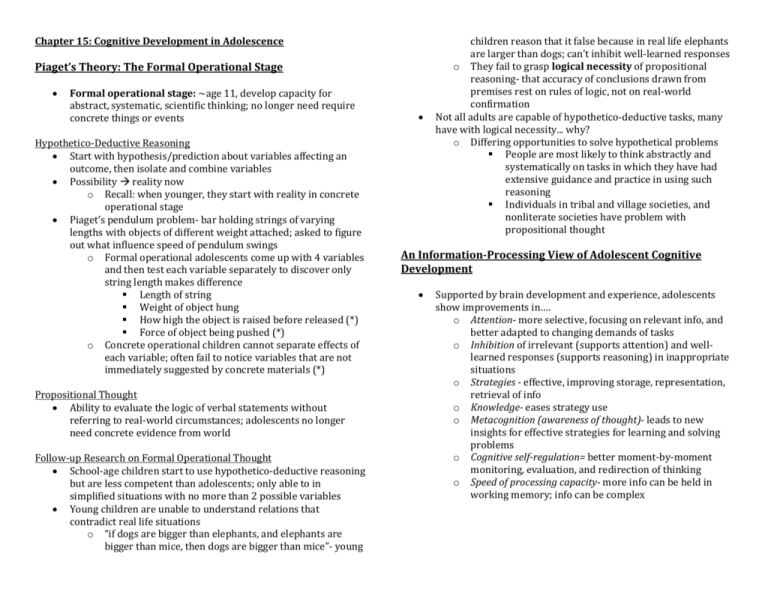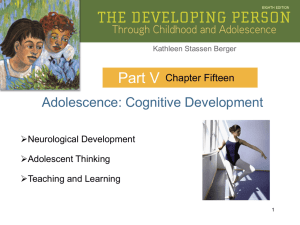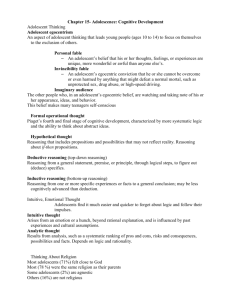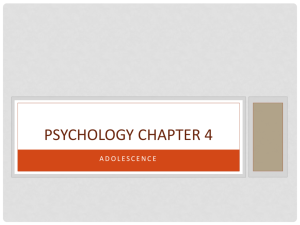File - Function of Play Part 1
advertisement

Chapter 15: Cognitive Development in Adolescence Piaget’s Theory: The Formal Operational Stage Formal operational stage: ~age 11, develop capacity for abstract, systematic, scientific thinking; no longer need require concrete things or events Hypothetico-Deductive Reasoning Start with hypothesis/prediction about variables affecting an outcome, then isolate and combine variables Possibility reality now o Recall: when younger, they start with reality in concrete operational stage Piaget’s pendulum problem- bar holding strings of varying lengths with objects of different weight attached; asked to figure out what influence speed of pendulum swings o Formal operational adolescents come up with 4 variables and then test each variable separately to discover only string length makes difference Length of string Weight of object hung How high the object is raised before released (*) Force of object being pushed (*) o Concrete operational children cannot separate effects of each variable; often fail to notice variables that are not immediately suggested by concrete materials (*) Propositional Thought Ability to evaluate the logic of verbal statements without referring to real-world circumstances; adolescents no longer need concrete evidence from world Follow-up Research on Formal Operational Thought School-age children start to use hypothetico-deductive reasoning but are less competent than adolescents; only able to in simplified situations with no more than 2 possible variables Young children are unable to understand relations that contradict real life situations o “if dogs are bigger than elephants, and elephants are bigger than mice, then dogs are bigger than mice”- young children reason that it false because in real life elephants are larger than dogs; can’t inhibit well-learned responses o They fail to grasp logical necessity of propositional reasoning- that accuracy of conclusions drawn from premises rest on rules of logic, not on real-world confirmation Not all adults are capable of hypothetico-deductive tasks, many have with logical necessity... why? o Differing opportunities to solve hypothetical problems People are most likely to think abstractly and systematically on tasks in which they have had extensive guidance and practice in using such reasoning Individuals in tribal and village societies, and nonliterate societies have problem with propositional thought An Information-Processing View of Adolescent Cognitive Development Supported by brain development and experience, adolescents show improvements in…. o Attention- more selective, focusing on relevant info, and better adapted to changing demands of tasks o Inhibition of irrelevant (supports attention) and welllearned responses (supports reasoning) in inappropriate situations o Strategies - effective, improving storage, representation, retrieval of info o Knowledge- eases strategy use o Metacognition (awareness of thought)- leads to new insights for effective strategies for learning and solving problems o Cognitive self-regulation= better moment-by-moment monitoring, evaluation, and redirection of thinking o Speed of processing capacity- more info can be held in working memory; info can be complex Scientific Reasoning: Coordinating Theory with Evidence Sometimes theories are not supported by evidence Children often blend theories and evidence into a single representation of “the way things are”, ignoring conflicting evidence or distort it in ways to be consistent with their theory Capacity to reason like a scientist (theories need to be supported by evidence to be true) improve with age How Scientific Reasoning Develops Greater working-memory capacity permits theories and effects of variables to be compared at once Scientific reasoning is strongly influenced by years of schooling o Increasing exposure to complex problems and instruction of features of scientific reasoning Through metacognitive understanding- ability to think about theories, deliberately isolate variables, and actively seek disconfirming evidence Through metacognitive capacity to evaluate one’s objectivity- to be fair-minded rather than show self-serving bias (applying logic more effectively to ideas they doubt than to ideas they favour) Consequences of Adolescent Cognitive Changes Self-Consciousness and Self-Focusing Imaginary audience- belief that they are the focus on everyone else’s attention and concern, become extremely self-conscious and try to avoid embarrassment, belief that everyone is monitoring their performance o Can have positive, protective functions- reflects value of holding onto relationships even as they struggle to separate from parents and establish an independent sense of self Personal fable- belief that others are observing and thinking about them, develop an inflated opinion of their own importance, that they are special and unique o Predicts self-esteem and overall positive adjustment in coping with challenge of adolescence o But can have negative impacts Focusing on distinctiveness of one’s own experience may interfere with forming close, rewarding relationships= decrease social support Can contribute to risk-taking behaviours because of their sensation-seeking personality and reduced sense of vulnerability ie. more sexual risks, drugs, delinquent acts Not a new form of egocentrism; rather, they are an outgrowth of advances in perspective taking Idealism and Criticism Adolescents’ constructions of ideal worlds and grand visions conflict with adults’ greater realism, creating tension between parent and child Teenage idealism and criticisms are advantageous bc they have a greater capacity to work for social change and form positive and lasting relationship s when they can see people as having strengths and weaknesses Decision Making Teens perform less well than adults in planning and decision making, requires inhibition of emotion and impulses to think rationally Steps to good decision making 1. Identify pros and cons of each alternative 2. Assess likelihood of various outcomes 3. Evaluate if chosen goals were met 4. If not met, learn from mistake and making better future decision Adolescents, more often than adults, fall back on well-learned intuitive judgments, “feel-good”behaviours, and addressing short- term over long-term goals when making decisions Efforts to choose best decisions may break down because of increasing number of decisions in adolescence Handling Consequences of Teenagers’ New Cognitive Capacities Sensitivity to public criticism- refrain from finding fault with adolescent in front of others Exaggerated sense of personal uniqueness- acknowledge adolescent’s unique characteristic Idealism and criticism- respond patient to their grand expectations and critical remarks; help them see all people are blends of virtues and imperfections Difficulty making everyday decisions- refrain from deciding for them, model effective decision making, offer suggestions about pros and cons, learning from poor choices Sex Differences in Mental Abilities Girls Verbal Abilities - Score higher on tests of verbal ability - Increased advantage in reading and writing achievement - Benefit from a biological advantage and more verbal stimulation - Differences in literacy skills is a contributing factor to widening gender gap in college enrollment Boys Mathematical Abilities - Start outperforming girls at early adolescence, when math concepts become more abstract and less spatial - Show advantage in science when problems become more complex - But gap is small, and has diminished over 30 years - Heredity, social pressures, and parental attitudes are contributing factors Language Development Vocabulary and Grammar Add variety of abstract words to their vocabularies; improve in clarity and accuracy Master sarcasm and irony Understand figurative language o Proverbs are especially challenge; used to comment, advise, warn and encourage Use more elaborate grammatical constructions- longer sentences with more subordinate clauses o Perspective-taken skill improved though persuasive speaking and writing, more connecting words used (ie. moreover) More effectively analyze and correct their grammar; grammatically accurate written expression is best learned in writing contexts Pragmatics Improved capacity to adapt language style to social context Teens are more likely than school-age children to practice what they want to say in an expected situation, review what they say, and figure out how they could say it better Learning in School School Transitions With each school change, grades decline o Tighter academic standards o High school- less personal attention, more whole-class instruction, less chance to participate o Feel less academically competent, liking and motivation for school declines Girls are more worrisome than boys o Self-esteem drops upon entering middle school Same time as life changes- puberty and dating o Feel lonelier and more anxious in high school Added strains (family disruption, poverty, low parental involvement, high parental conflict, learned helplessness) increase risk for self-esteem and academic difficulties To help them adjust to school transitions: o Support from parents, teachers, peers Parental involvement, monitoring, gradual autonomy granting, emphasis on mastery than good grades o Those with close friends able to sustain friendship across transition have increased social integration and academic motivation in new school o Extracurricular involvement Academic Achievement Child-rearing styles o Authoritative parenting= higher grades Joint parent-adolescent decision making Parent involvement in adolescent’s education Parent-school partnerships o High-achieving students typically have parents who evaluate child’s progress, communicate with teacher, evaluate if classes are challenging and well-taught Peer influences o Important role; teens tend to chose friends who share same values (ie. Academic achievement values) o Academically high-performing friends may also avoid drugs, engage in responsible behavior, participate in extracurriculars School characteristics o Environments should be responsive to growing cognitive, emotional and social needs o Classroom learning experiences (584), tracking(585) Dropping Out ~8% of U.S. 13-24 year olds drop out of high school and remain without diploma or GED Rate higher for boys, particularly high among low-SES ethnic minorities, especially Native-American and Hispanic teens Factors related to dropping out (table on 588) o Student characteristics o Family o School and community Prevention strategies o Remedial instruction and counseling that offer personalized attention o High-quality vocational education o Efforts to address factors in students’ lives related to leaving school early o Participation in extracurricular activities Vocational Development Selecting a Vocation: Phases (Gottfredson, Super) Fantasy Tentative Realistic Early and middle childhood Fantasize career options dependent on their preferences, familiarity, glamour, excitement Ages 11-16 Based on interests, then abilities (personal and educational requirements) and values Late teens-early 20s Narrow options; exploration- gathering info about possibilities that match their personal characteristic Crystallization- focus on general vocational category before settling on single occupation Factors Influencing Vocational Choice Personality o People are attracted to occupations that complement their personalities (Holland) Investigative person, enjoys working with ideas, likely scientific occupation Social, like interacting with people, gravitates towards human services Realistic, prefers real-world problems and work with objects, tend to choose mechanics Artistic, emotional and high in need for individual expression, looks towards artistic field Conventional person, likes well-structured tasks and values material possessions and social status, business fields Enterprising person, adventurous, persuasive, strong leader, drawn to sales, supervisory positions, or politics Family influences o Strongly correlated with parents’ jobs and SES o Higher SES parents have access to important information about education and work, and connections Promote curiosity and self-direction- required for high-status careers Lower SES emphasize conformity and obedience Parenting practices also shape work-related preferences Parents can still foster high aspirations; encouragements to do well in school and toward high-status occupations Teachers o College-bound teens tend to have closer relationships with teachers than do other students- likely to foster high career aspirations o Students with academic and behavioural problems generally have neither family nor teach supports o Teachers can offer encouragement, act as role models Gender stereotypes o Although women are entering and excelling in maledominated professions, majority remain in less-wellpaid, traditionally feminine professions o Ability cannot account for sex differences… it’s the gender-stereotyped messages! Recall: although girls are better in reading and writing, gender gap favouring boys in math is small Although girls earn higher grades than boys, they reach sec. school less confident of their abilities, more likely to underestimate achievement, and less likely to express interest in math and science In college, women may worry about combining highly demanding career with family responsibilities o o o Vocational Preparation of Non-College-Bound Adolescents ~1/3 of U.S. young people with high school diploma have no plans to go to college Although they are more likely to find employment than youth who drop out, they fewer work opportunities than high school graduates of several decades ago U.S. non-college bound high school graduates are poorly prepared for skilled businesses; limited to low-paid, unskilled jobs, many unemployed









